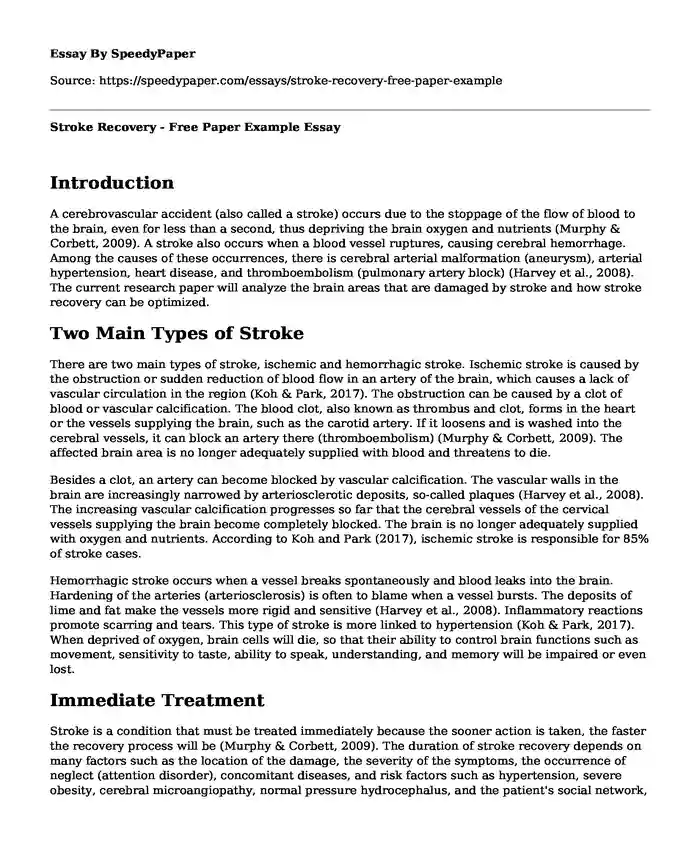
| Type of paper: | Essay |
| Categories: | Medicine Healthcare |
| Pages: | 3 |
| Wordcount: | 782 words |
Introduction
A cerebrovascular accident (also called a stroke) occurs due to the stoppage of the flow of blood to the brain, even for less than a second, thus depriving the brain oxygen and nutrients (Murphy & Corbett, 2009). A stroke also occurs when a blood vessel ruptures, causing cerebral hemorrhage. Among the causes of these occurrences, there is cerebral arterial malformation (aneurysm), arterial hypertension, heart disease, and thromboembolism (pulmonary artery block) (Harvey et al., 2008). The current research paper will analyze the brain areas that are damaged by stroke and how stroke recovery can be optimized.
Two Main Types of Stroke
There are two main types of stroke, ischemic and hemorrhagic stroke. Ischemic stroke is caused by the obstruction or sudden reduction of blood flow in an artery of the brain, which causes a lack of vascular circulation in the region (Koh & Park, 2017). The obstruction can be caused by a clot of blood or vascular calcification. The blood clot, also known as thrombus and clot, forms in the heart or the vessels supplying the brain, such as the carotid artery. If it loosens and is washed into the cerebral vessels, it can block an artery there (thromboembolism) (Murphy & Corbett, 2009). The affected brain area is no longer adequately supplied with blood and threatens to die.
Besides a clot, an artery can become blocked by vascular calcification. The vascular walls in the brain are increasingly narrowed by arteriosclerotic deposits, so-called plaques (Harvey et al., 2008). The increasing vascular calcification progresses so far that the cerebral vessels of the cervical vessels supplying the brain become completely blocked. The brain is no longer adequately supplied with oxygen and nutrients. According to Koh and Park (2017), ischemic stroke is responsible for 85% of stroke cases.
Hemorrhagic stroke occurs when a vessel breaks spontaneously and blood leaks into the brain. Hardening of the arteries (arteriosclerosis) is often to blame when a vessel bursts. The deposits of lime and fat make the vessels more rigid and sensitive (Harvey et al., 2008). Inflammatory reactions promote scarring and tears. This type of stroke is more linked to hypertension (Koh & Park, 2017). When deprived of oxygen, brain cells will die, so that their ability to control brain functions such as movement, sensitivity to taste, ability to speak, understanding, and memory will be impaired or even lost.
Immediate Treatment
Stroke is a condition that must be treated immediately because the sooner action is taken, the faster the recovery process will be (Murphy & Corbett, 2009). The duration of stroke recovery depends on many factors such as the location of the damage, the severity of the symptoms, the occurrence of neglect (attention disorder), concomitant diseases, and risk factors such as hypertension, severe obesity, cerebral microangiopathy, normal pressure hydrocephalus, and the patient's social network, i.e. support from his environment and previous education (Harvey et al., 2008). Many patients and some of their relatives develop depression in the course of recovery and rehabilitation, which must be treated (Koh & Park, 2017). The length of recovery from this disease also depends on how widely the stroke attacks the patient's brain. The more extensive the part of the brain that is blocked or bleeding, the longer the treatment time will be needed.
Conclusion
Recovery is always the task of a team, i.e. doctors, nursing staff, special therapists, but also the family and friends of the person affected must work together over a long period of time from the beginning. When the critical phase of the first few days is over, early rehabilitation begins immediately. With the help of physical therapists, speech therapists, occupational therapists, and under the guidance of carers and nurses, the patients learn to find the lost functions again. The earlier the recovery begins, the better. Additionally, the faster it is handled with the right method, the faster the treatment process will be until the patient recovers. Often, stroke patients indulge themselves by limiting body movements, even though this disease must be fought by moving a lot so that the healing process will be faster. Moreover, the support of the family and the medical team, as well as the motivation of the patient, also optimize the success and duration of stroke treatment.
References
Koh, S. H., & Park, H. H. (2017). Neurogenesis in stroke recovery. Translational stroke research, 8(1), 3-13. https://link.springer.com/article/10.1007/s12975-016-0460-z
Murphy, T. H., & Corbett, D. (2009). Plasticity during stroke recovery: from synapse to behavior. Nature Reviews Neuroscience, 10(12), 861-872. https://www.researchgate.net/publication/38066056_Plasticity_during_stroke_recovery_from_synapse_to_behaviour
Harvey, R. L., Macko, R. F., Stein, J., Winstein, C. J., & Zorowitz, R. D. (Eds.). (2008). Stroke recovery and rehabilitation. Demos Medical Publishing.
https://www.amazon.com/Stroke-Recovery-Rehabilitation-Joel-Stein/dp/1933864125.
Cite this page
Stroke Recovery - Free Paper Example. (2023, Nov 25). Retrieved from https://speedypaper.com/essays/stroke-recovery-free-paper-example
Request Removal
If you are the original author of this essay and no longer wish to have it published on the SpeedyPaper website, please click below to request its removal:
- Medical Malpractice Essay Sample
- Free Essay on Screening Guidelines: Mammogram
- Essay Sample: Nursing Theory Selected As a Guide for Practicum Experience
- Free Essay: A Summary of a Group Work on Applying Stages of Change to Complex Behaviors
- Paper Example. Inductive Argument from Analogy
- Essay on Abortion: A Complex Debate on Life & Death Matters
- Understanding Historical Views on Slavery and Mental Health - Free Paper Sample
Popular categories




